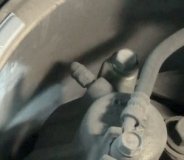All the symptoms you described sound exactly like a very common problem on front-wheel-drive GM cars. To my knowledge this doesn't apply to any other brands, but given all you've done already, lets treat this like a GM car. They have a valve inside the master cylinder that moves when equal pressures do not build up in the two hydraulic circuits. This is a nice feature when one part develops a leak, but it also leads to lots of frustration and wasted money when trying to diagnose it.
That valve will also trip when pedal-bleeding the system, and when simply replacing the pads, then pumping the brake pedal to run the pistons out of the caliper housings to adjust them. One piston will naturally move first, then pressure will start to build before that has taken place in the other circuit. No professional will ever push the brake pedal more than half way to the floor, to avoid running the rubber lip seals over the crud that builds up in the lower halves of the bores where the pistons don't normally travel, but it's even more important on GM cars to avoid tripping that valve.
The glaring clues are the failure of the right front pads to wear as fast as those on the left side, and the inability to get brake fluid to flow from the right front caliper. Most front-wheel-drive cars use a "split-diagonal" hydraulic system that puts the left front and the right rear brakes on the same circuit. That means you should also be unable to get fluid to flow from the left rear brake. The additional clue is the brake pull to the left. With one inoperative front brake on an older rear-wheel-drive car, applying the brakes would tear the steering wheel out of your hands so hard you'd be unable to hold onto it. Because this is expected to happen with split-diagonal brakes when one side develops a leak, the front suspension geometry has been modified so one of the little-known alignment angles offsets that brake pull. Chrysler has that so perfected, the only way you'll know there's a problem is the red "Brake" warning light will turn on from the unequal pressures. For most other manufacturers, all you'll see is a very tiny wiggle in the steering wheel when the brakes are applied.
Many people replace the master cylinder for this problem, then cause it right away again by pedal-bleeding with a helper. It is not necessary to replace the master cylinder, but the valve must be reset manually, then just use gravity-bleeding with no helper pushing the pedal. The only way I've ever found to reset the valve is to loosen the cap on the master cylinder's reservoir, open the bleeder screw on one caliper or wheel cylinder that isn't flowing any fluid, then give that bleeder screw a very short, quick spurt of compressed air. Let that wheel gravity-bleed after that.
The goal is to avoid pushing air all the way back to the master cylinder because it will just have to be bled out again. I use a rubber-tipped air nozzle, and I give it quick smack with my fist. Air only goes a few inches into the line, and that bleeds back out in less than 30 seconds.
Sunday, April 28th, 2019 AT 10:33 PM


